| The Alien Lives of Parasites |
-A female blood fluke spends its life of constant intercourse lodged in a groove along the
front of the larger, canoe-shaped male. These tiny flatworms cause little harm themselves, but
their thousands of spiny eggs trigger immune system reactions that can lead to tissue
damage and internal bleeding. They inhabit the blood vessels serving the intestines.
front of the larger, canoe-shaped male. These tiny flatworms cause little harm themselves, but
their thousands of spiny eggs trigger immune system reactions that can lead to tissue
damage and internal bleeding. They inhabit the blood vessels serving the intestines.
-Female "chigoe" or "sticktight" fleas (also known as "jiggers") dig themselves into the flesh
of their hosts, which can include man. Once fertilized by a free-roaming male, the female's
midsection expands "like a life preserver," making it more difficult to remove as it eventually
swells to the size of a pea. After she deposits her eggs, the bloated insect dies, still buried
under the host's flesh and often causing secondary infection.
of their hosts, which can include man. Once fertilized by a free-roaming male, the female's
midsection expands "like a life preserver," making it more difficult to remove as it eventually
swells to the size of a pea. After she deposits her eggs, the bloated insect dies, still buried
under the host's flesh and often causing secondary infection.
-Wuchereria bancrofti is a microscopic nematode responsible for one of the world's
strangest and most debilitating diseases: elephantiasis, characterized by extreme, incurable
disfiguration and massive growth of the legs and genitalia. These worms inhabit the lymph
nodes and ducts, resulting in blockage and swelling of tissues.
strangest and most debilitating diseases: elephantiasis, characterized by extreme, incurable
disfiguration and massive growth of the legs and genitalia. These worms inhabit the lymph
nodes and ducts, resulting in blockage and swelling of tissues.
-The life cycle of the lancet fluke (Dicrocoelium dendriticum) goes as follows: adults inhabit
sheep or other grazers, releasing eggs that are spread in manure. When swallowed by
scavenging snails, the eggs hatch and the parasites are eventually coughed up by the snail in
balls of slime, which are then consumed by ants. Late in the evening as the temperature
drops, infected ants experience an uncontrollable urge to wander from their colony, climb a
blade of grass and attach to the tip by their jaws. The ants will remain in this position until
accidentally eaten by a large, grazing mammal... beginning the cycle anew.
sheep or other grazers, releasing eggs that are spread in manure. When swallowed by
scavenging snails, the eggs hatch and the parasites are eventually coughed up by the snail in
balls of slime, which are then consumed by ants. Late in the evening as the temperature
drops, infected ants experience an uncontrollable urge to wander from their colony, climb a
blade of grass and attach to the tip by their jaws. The ants will remain in this position until
accidentally eaten by a large, grazing mammal... beginning the cycle anew.
-Cattle avoid eating near their own manure, which may contain thousands of expelled
parasites, but one parasitic fungus increases the odds of reinfection by "firing" its spores up
to several meters away... and another parasite, the lung worm Dictyocaulus arnfieldi, climbs
atop these spores to hitch a ride.
parasites, but one parasitic fungus increases the odds of reinfection by "firing" its spores up
to several meters away... and another parasite, the lung worm Dictyocaulus arnfieldi, climbs
atop these spores to hitch a ride.
-The infamous Oestridae, or "bots," are a family of flies whose large, spiny larvae live
parasitically in the bodies of mammals. Some species inhabit the nostrils or digestive tracts
of their hosts, while others burrow into the skin and excavate a large mucus-lined chamber.
Only one species is known to attack humans, but actually lays its eggs on the bodies of
mosquitoes. This allows the tiny maggots to be delivered by a much smaller, stealthier insect
than their mother. Once buried into human flesh, the baby bots can grow up to three inches in
length and cause considerable pain.
parasitically in the bodies of mammals. Some species inhabit the nostrils or digestive tracts
of their hosts, while others burrow into the skin and excavate a large mucus-lined chamber.
Only one species is known to attack humans, but actually lays its eggs on the bodies of
mosquitoes. This allows the tiny maggots to be delivered by a much smaller, stealthier insect
than their mother. Once buried into human flesh, the baby bots can grow up to three inches in
length and cause considerable pain.
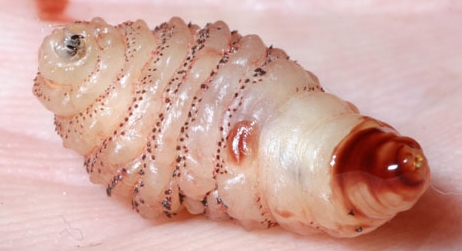
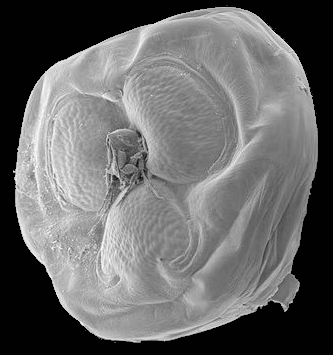
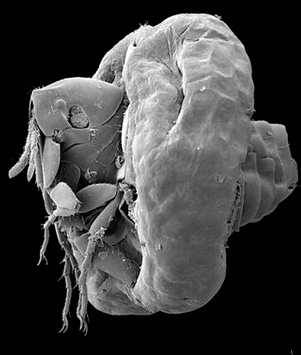

-A recently identified nematode parasite alters the coloration of its ant host's abdomen to
resemble a local berry. When mistakenly eaten by a bird, the parasite completes its life cycle
and spreads its eggs in the bird's droppings, much like the Leucochloridium.
resemble a local berry. When mistakenly eaten by a bird, the parasite completes its life cycle
and spreads its eggs in the bird's droppings, much like the Leucochloridium.
-The "Gordian" or "horsehair" worm Spinochordodes tellinii is a parasite of grasshoppers in
its larval state, while aquatic and free-living as an adult. At maturity, it induces its insect host to
seek out a body of water and drown itself.
its larval state, while aquatic and free-living as an adult. At maturity, it induces its insect host to
seek out a body of water and drown itself.

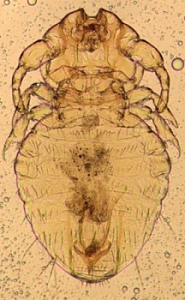

-For nearly every warm-blooded species known to man, there is at least one species of louse
uniquely adapted to its body; above are the lice of a pigeon, elephant and gopher.
Monotremes (platypi or echidnas), Cetaceans (whales or porpoises), pangolins and bats are
the only mammals without lice of their own, and we humans are the only species to host more
than one variety, both of which we contracted from other primates; human head lice are also
the lice that infest chimpanzees, while our body lice originated from gorillas. It was by hunting
and feeding on these apes that our ancestors would have picked up these insects, which
adapted to the two different types of hair that grow on our bodies (another unusual trait among
mammals.)
uniquely adapted to its body; above are the lice of a pigeon, elephant and gopher.
Monotremes (platypi or echidnas), Cetaceans (whales or porpoises), pangolins and bats are
the only mammals without lice of their own, and we humans are the only species to host more
than one variety, both of which we contracted from other primates; human head lice are also
the lice that infest chimpanzees, while our body lice originated from gorillas. It was by hunting
and feeding on these apes that our ancestors would have picked up these insects, which
adapted to the two different types of hair that grow on our bodies (another unusual trait among
mammals.)
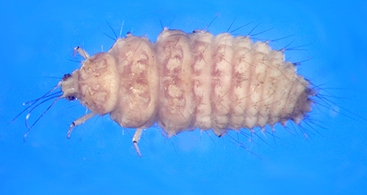
-Among the few vertebrate parasites known to man, the degenerate "pearl fish" dwell within
the anal cavities of sea cucumbers (Echinoderms related to starfish) and nibble on the
surrounding tissues. Fortunately, their home can regenerate quickly. Their thin, tapered tails
are perfectly adapted to help force their bodies in and out of their home. Ouch.
the anal cavities of sea cucumbers (Echinoderms related to starfish) and nibble on the
surrounding tissues. Fortunately, their home can regenerate quickly. Their thin, tapered tails
are perfectly adapted to help force their bodies in and out of their home. Ouch.
-Potentially the most obscure animal on this entire page, the aquatic larva of the Spongilla fly
feeds exclusively on the tissues of freshwater sponges, which I'm not surprised you never
knew existed.
feeds exclusively on the tissues of freshwater sponges, which I'm not surprised you never
knew existed.

| Written by Jonathan C. Wojcik - Photo credits unknown or from public news outlets. |
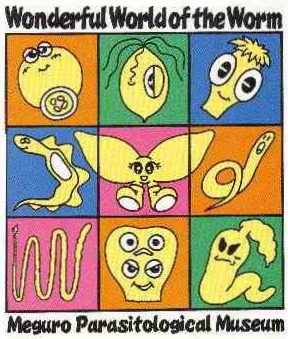
Degenerate. Lowly. Primitive. These are terms which, to many people, are immediately
brought to mind by the word "parasite." Even science was once guilty of labeling
parasitic life as a sort of "de-volution," a slothful step back for creatures that couldn't cut it
on their own. Little did we realize, survival in the body of another creature entails extreme
adaptation which, more often than not, surpasses the sophistication and craftiness of any
"free living" life-form.
brought to mind by the word "parasite." Even science was once guilty of labeling
parasitic life as a sort of "de-volution," a slothful step back for creatures that couldn't cut it
on their own. Little did we realize, survival in the body of another creature entails extreme
adaptation which, more often than not, surpasses the sophistication and craftiness of any
"free living" life-form.
As you read this, every macroscopic animal
on this planet is harboring at least one
species of parasite in or on its body,
including yourself. With more discovered year
after year, parasitic species may easily
outnumber the non-parasitic, and their
tremendous importance to the ecosystem
becomes more apparent the more they are
observed.
Parasites have an influence on which animals
are preyed upon, which animals mate and
which animals evolve. There is even strong
evidence that some or all human behavior -
our tastes in the opposite sex, our sleeping
habits, our every mental quirk - is subtly
manipulated by the microorganisms that
invade our bodies.
on this planet is harboring at least one
species of parasite in or on its body,
including yourself. With more discovered year
after year, parasitic species may easily
outnumber the non-parasitic, and their
tremendous importance to the ecosystem
becomes more apparent the more they are
observed.
Parasites have an influence on which animals
are preyed upon, which animals mate and
which animals evolve. There is even strong
evidence that some or all human behavior -
our tastes in the opposite sex, our sleeping
habits, our every mental quirk - is subtly
manipulated by the microorganisms that
invade our bodies.